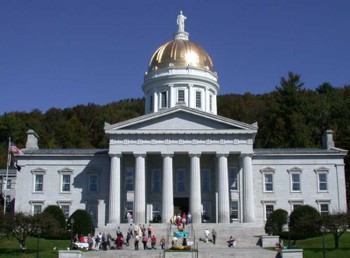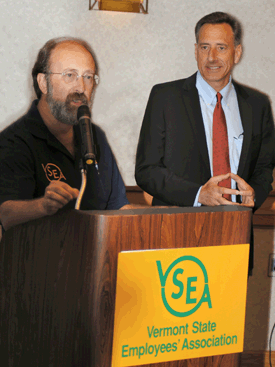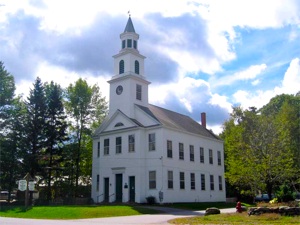 You don’t see the Vermont governor criticizing public employees, like leaders in New Jersey, Maine, Wisconsin and other states. No members have walked out of the Vermont Legislature, which is considering legislation to require an increase in public employee pension contributions. State employee unions are not protesting at the capital. Why?
You don’t see the Vermont governor criticizing public employees, like leaders in New Jersey, Maine, Wisconsin and other states. No members have walked out of the Vermont Legislature, which is considering legislation to require an increase in public employee pension contributions. State employee unions are not protesting at the capital. Why?
Vermont’s public pension problems differ very little from those in New Jersey or Maine: The state fell behind on its payments to cover the cost of retirement benefits. Stock market losses during the recession widened the gap. Vermont’s workers are aging, so retirement costs are going up.
Vermont has avoided the acrimony in other states by taking a more civil approach to its public pension crisis: sitting down and working out differences with its unions. State workers have had to promise a lot of sacrifices — pay cuts, layoffs, higher contributions to their pension plan and additional years before they can retire. The tradeoff is that they have made their pension system more secure while helping to trim Vermont’s budget shortfall.
On his first day in office, Governor Peter Shumlin invited union leaders to his office to talk about Vermont’s financial challenges. “In my experience, you get more with maple syrup than vinegar.”
“I’m puzzled by the approach taken by some of my colleagues who prefer confrontation to common sense,” Shumlin said in an interview with Stateline.
Whether the Vermont way can be exported to states currently involved in contentious fights with their public employees is an open question. But the state does offer an alternative approach that has produced success.
 In the past 14 months, Vermont state employees voted to accept a two-year, 3 percent pay cut, the first in the state’s history that has happened. The state’s teachers agreed to a plan requiring them to work three additional years before retiring and contribute 1.6 percent more of their pay towards their pension. The state’s other large union, which represents most public workers outside of education, voted to increase pension contributions by 1.3 percent over the next five years; the governor and legislative leaders say they will approve it.
In the past 14 months, Vermont state employees voted to accept a two-year, 3 percent pay cut, the first in the state’s history that has happened. The state’s teachers agreed to a plan requiring them to work three additional years before retiring and contribute 1.6 percent more of their pay towards their pension. The state’s other large union, which represents most public workers outside of education, voted to increase pension contributions by 1.3 percent over the next five years; the governor and legislative leaders say they will approve it.
The state is reaping significant savings from the public pension cuts. Vermont’s budget shortfall of about $150 million will shrink $15 million in the current fiscal year from the teacher retirement reforms, $2 million from the pay cut and $5 million from the higher state employee contributions. Teachers keep their defined benefit plan, with larger retirement checks. Other state workers retain current pension benefits, although their checks do not go up. (Photo: Bob Hooper, president of the Vermont State Employees Association, developed a close working relationship with Governor Peter Shumlin, right)
Unionized employees get the satisfaction of knowing that they are easing the state’s financial troubles, which in turn strengthens Vermont’s ability to keep up with its public pension contributions. Like Wisconsin workers who agreed to cuts in pension and other benefits, this sense of self-sacrifice matters. The unions “have a sense of the challenges their friends and neighbors who are paying their salaries are facing,” former Vermont Governor James Douglas, a Republican, said in an interview.
The union president, Bob Hooper, says the union is willing “to help the state with its budget problem” providing that the increase is in effect for five years or until the pension system reaches full funding, whichever comes first. Shumlin and legislative leaders say they will accept the union’s offer and approve legislation enacting it into law. “Our objective was to retain our benefits level and the easiest way to do that was to make an increased contribution,” Hooper explains.
The willingness of unions to help solve Vermont’s financial problems stems in part from the fact that union officials are members of the state retirement board. In that way, unions have access to the financial data of public pension plans showing the long term challenges.
 Something else is happening, though. University of Vermont business professor Michael Gurdon calls it the “town meeting syndrome.” Dating back to the late 1700s, Vermont residents traditionally have come together each year to discuss issues of their community and state; the so-called town meeting day now is the first Tuesday in March. The familiarity fosters an atmosphere of mutual respect.
Something else is happening, though. University of Vermont business professor Michael Gurdon calls it the “town meeting syndrome.” Dating back to the late 1700s, Vermont residents traditionally have come together each year to discuss issues of their community and state; the so-called town meeting day now is the first Tuesday in March. The familiarity fosters an atmosphere of mutual respect.
In small school districts parents get to know the local teachers, who are not highly paid. At the same time, Gurdon says, teachers “are well aware of the travails of their town neighbors and their property taxing limitations. Thus, there is some moderation in collective bargaining and even a willingness to share the sacrifice.”




















It’s encouraging to know that there is still at least [i]some[/i] commonsense and rationality to be found in the governments of the world.